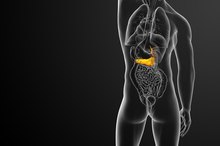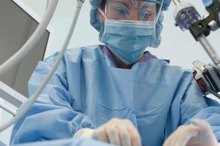Gallbladder infection is a serious, potentially life-threatening complication of gallstone disease 4. Infection most commonly occurs due to persistent gallstone obstruction of one of the ducts that transport bile from the gallbladder to the intestine. Bacteria in the bile may lead to gallbladder gangrene, rupture, abscess or a bloodstream infection. Recognizing symptoms that may indicate a gallbladder infection proves important, as this condition requires urgent medical treatment.
If you are experiencing serious medical symptoms, seek emergency treatment immediately.
Fever
Fever is a characteristic symptom of gallbladder infection. Since fever generally does not occur with a typical gallbladder attack, the presence of fever is an important distinguishing characteristic that points to the likely presence of infection. Fever is the most common symptom of gallbladder and bile system infection, occurring in at least 90 percent of people with the condition. Chills are also common. A sudden temperature spike in someone with gallbladder-related symptoms may indicate the development of gallbladder gangrene or rupture, or the development of a bloodstream infection.
- Fever is a characteristic symptom of gallbladder infection.
- Fever is the most common symptom of gallbladder and bile system infection, occurring in at least 90 percent of people with the condition.
Gallbladder Pain
Side Effects of Gallstones
Learn More
Gallbladder infection typically causes severe pain, which usually begins in the right or middle upper abdomen. This is the same location of pain associated with a gallbladder attack. Over time, however, the pain increases in intensity and becomes more generalized, a characteristic that helps distinguish a gallbladder infection from a gallbladder attack. The pain is also more enduring than that of a simple gallbladder attack. Gallbladder-like pain that lasts more than 6 hours points to the possibility of a gallbladder infection.
- Gallbladder infection typically causes severe pain, which usually begins in the right or middle upper abdomen.
- Over time, however, the pain increases in intensity and becomes more generalized, a characteristic that helps distinguish a gallbladder infection from a gallbladder attack.
Abdominal Pain and Tenderness
The right upper abdomen is typically tender to pressure with a gallbladder infection. Signs of abdominal cavity inflammation also commonly occur, such as breath-stopping pain with deep inhalation. The abdominal wall muscles may involuntarily contract when the abdomen is pressed upon, a sign known as abdominal guarding. Unrelenting rigidity of the abdominal wall muscles may indicate gallbladder gangrene. Temporarily diminished abdominal pain followed by the return of severe, generalized pain may signal gallbladder rupture. Pain briefly abates when pressure within the gallbladder is alleviated by organ rupture, but returns as the infected bile contaminates the abdominal cavity.
- The right upper abdomen is typically tender to pressure with a gallbladder infection.
- Signs of abdominal cavity inflammation also commonly occur, such as breath-stopping pain with deep inhalation.
Gastrointestinal Disturbances and Jaundice
Cholesterolosis of the Gallbladder Symptoms
Learn More
Loss of appetite, nausea and vomiting often occur with an infected gallbladder, although these symptoms also prove common with a simple gallbladder attack. Abdominal distension caused by decreased intestinal activity and fluid accumulation in the abdominal cavity in response to gallbladder infection or inflammation may also occur. Yellowish discoloration of the skin, or jaundice, occurs frequently due to obstruction of bile flow from gallbladder.
Rapid Heart Rate and Breathing, and Confusion
A racing heartbeat, rapid breathing and confusion are typical symptoms of shock, which may develop if a gallbladder infection spreads to the bloodstream. The blood pressure falls to a dangerously low level with shock, which often causes confusion, dizziness, lightheadedness or fainting. The body tries to compensate for the low blood pressure by increasing the heart rate. Shock can lead to organ failure in multiple body systems due to insufficient delivery of oxygen-rich blood. The development of shock is a medical emergency.
- A racing heartbeat, rapid breathing and confusion are typical symptoms of shock, which may develop if a gallbladder infection spreads to the bloodstream.
Warnings and Precautions
Seek emergency medical care if you develop symptoms that might indicate a gallbladder attack or infection. As the early signs and symptoms of these two conditions overlap, distinguishing between them typically requires medical testing and a period of close observation by healthcare professionals. A delay in treatment with a gallbladder infection increases the likelihood of a potentially life-threatening complication, such as a gallbladder rupture or spread of the infection to the bloodstream.
Related Articles
References
- Harrison's Principles of Internal Medicine, 18th Edition; Dan Longo, et al.
- Surgical Treatment, Evidence-Based and Problem-Oriented; Rene G. Holzheimer and John A. Mannick
- Merck Manual Professional Version: Choledocholithiasis and Cholangitis
- Clinical Infectious Disease, 2nd Edition; David Schlossberg
- National Institute of Diabetes and Digestive and Kidney Diseases. (n.d.). Gallstones. https://www.niddk.nih.gov/health-information/digestive-diseases/gallstones
- University of Maryland Medical Center. (2018). Gallstones and gallbladder disease. https://www.umms.org/ummc/patients-visitors/health-library/in-depth-patient-education-reports/articles/gallstones-and-gallbladder-disease
- Njeze GE. Gallstones. Niger J Surg. 2013;19(2):49-55. doi:10.4103/1117-6806.119236
- Maurer KJ, Carey MC, Fox JG. Roles of infection, inflammation, and the immune system in cholesterol gallstone formation. Gastroenterology. 2009;136(2):425-40. doi:10.1053/j.gastro.2008.12.031
- Halpin V. Acute cholecystitis. BMJ Clin Evid. 2014;2014:0411.
- Balmadrid B. Recent advances in management of acalculous cholecystitis. F1000Res. 2018;7: F1000 Faculty Rev-1660. doi:10.12688/f1000research.14886.1
- Ahmed M. Acute cholangitis - an update. World J Gastrointest Pathophysiol. 2018;9(1):1-7. doi:10.4291/wjgp.v9.i1.1
- Derici H, Kara C, Bozdag AD, Nazli O, Tansug T, Akca E. Diagnosis and treatment of gallbladder perforation. World J Gastroenterol. 2006;12(48):7832-6. doi:10.3748/wjg.v12.i48.7832
- Toouli J. Biliary Dyskinesia. Curr Treat Options Gastroenterol. 2002;5(4):285-291.
- Ahmed M, Diggory R. Acalculous gallbladder disease: the outcomes of treatment by laparoscopic cholecystectomy. Ann R Coll Surg Engl. 2011;93(3):209-12. doi:10.1308/003588411X563402
- Shaffer EA. Gallbladder cancer: the basics. Gastroenterol Hepatol (N Y). 2008;4(10):737-41.
- Wang JK, Foster SM, Wolff BG. Incidental gallstones. Perm J. 2009;13(2):50-4.
- Bree RL. Further observations on the usefulness of the sonographic Murphy sign in the evaluation of suspected acute cholecystitis. J Clin Ultrasound. 1995;23(3):169-72.
- Robinson P, Perkins JC. Approach to Patients with Epigastric Pain. Emerg Med Clin North Am. 2016;34(2):191-210. doi:10.1016/j.emc.2015.12.012
- Pejić MA, Milić DJ. [Surgical treatment of polypoid lesions of gallbladder]. Srp Arh Celok Lek. 2003;131(7-8):319-24.
- Genc V, Sulaimanov M, Cipe G, et al. What necessitates the conversion to open cholecystectomy? A retrospective analysis of 5164 consecutive laparoscopic operations. Clinics (Sao Paulo). 2011;66(3):417-20. doi:10.1590/S1807-59322011000300009
- Katzarov AK, Dunkov ZI, Popadiin I, Katzarov KS. How to measure quality in endoscopic retrograde cholangiopancreatography (ERCP). Ann Transl Med. 2018;6(13):265. doi:10.21037/atm.2018.05.01
- Catalano MF, Thosani NC. (2016). Clinical manifestations and diagnosis of sphincter of Oddi dysfunction. Howell DA (ed). UpToDate, Waltham, MA: UpToDate Inc.
- Lee JY, Keane MG, Pereira S. Diagnosis and treatment of gallstone disease. Practitioner. 2015 Jun;259(1783):15-9,2.
- National Institute of Diabetes and Digestive and Kidney Diseases. (n.d.). Gallstones.
- University of Maryland Medical Center. (2018). Gallstones and gallbladder disease.
Writer Bio
Dr. Tina M. St. John owns and operates a health communications and consulting firm. She is also an accomplished medical writer and editor, and was formerly a senior medical officer with the U.S. Centers for Disease Control and Prevention. St. John holds an M.D. from Emory University School of Medicine.









